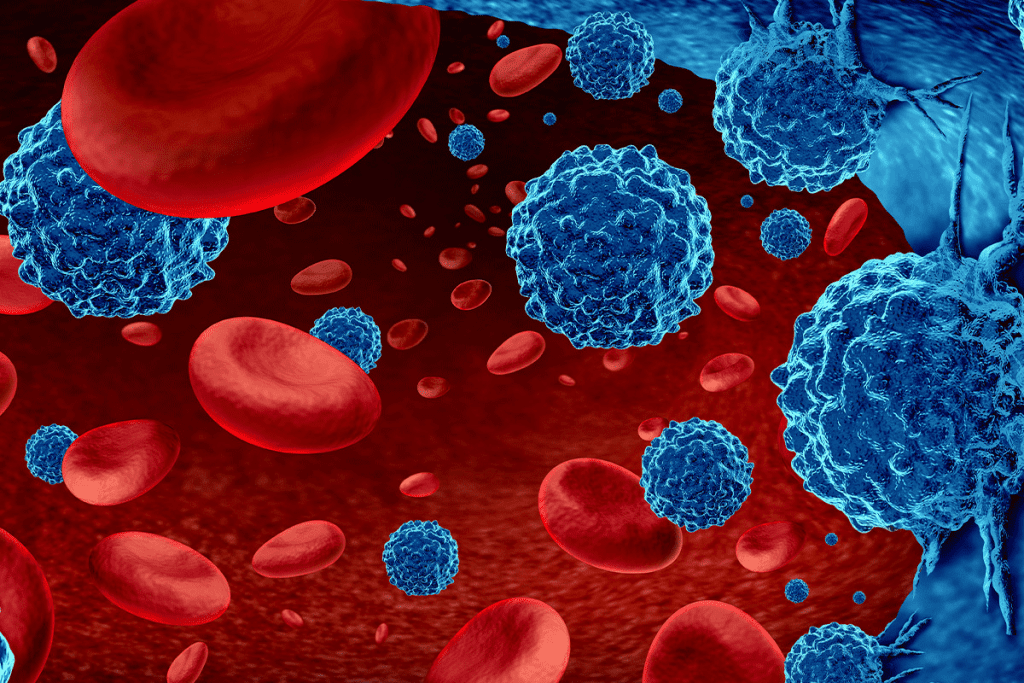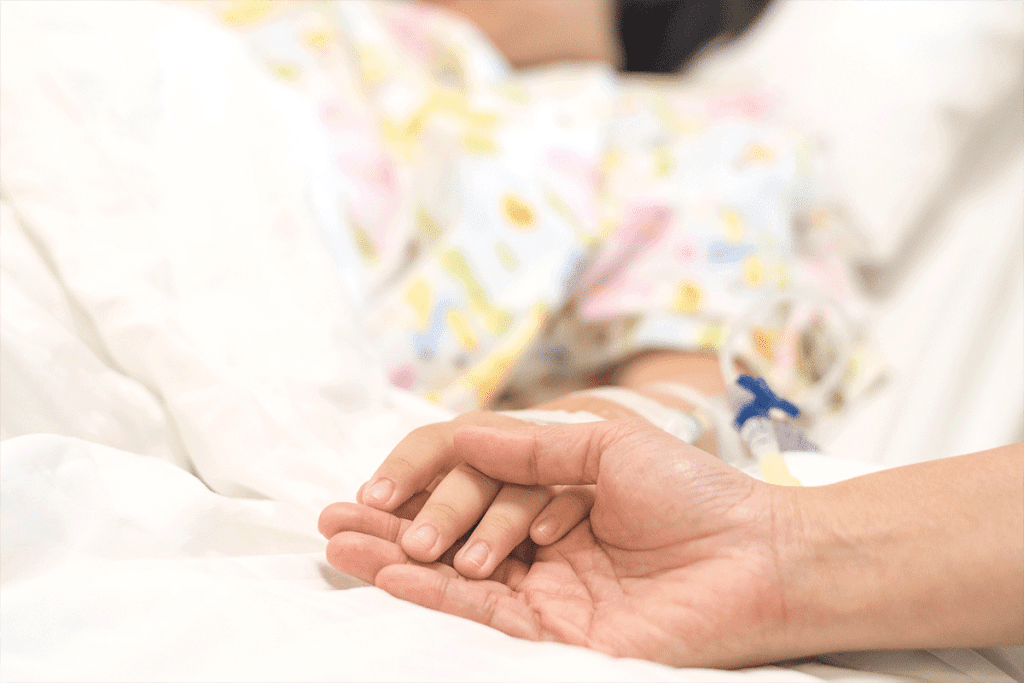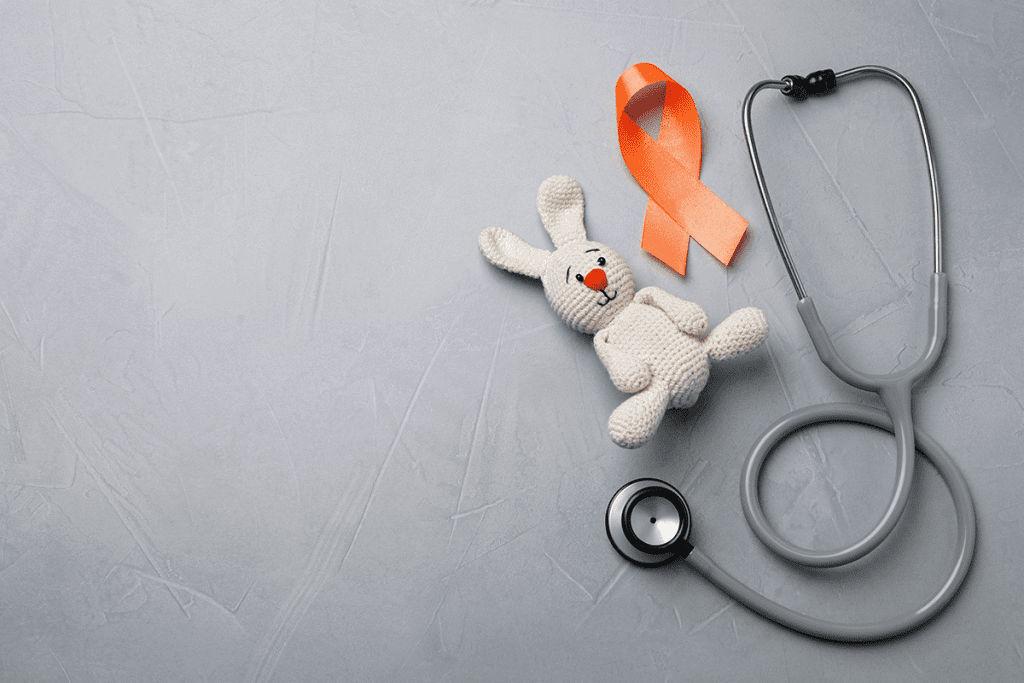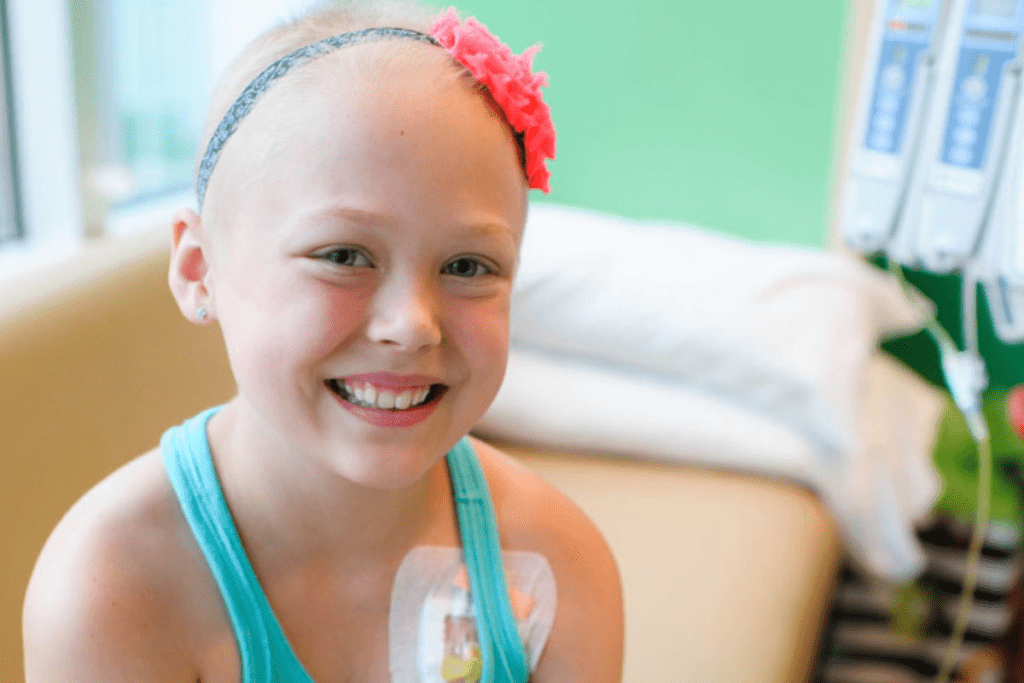Last Updated on October 21, 2025 by mcelik
A parent’s guide to immunotherapy for leukemia in children. Learn about CAR T-cell therapy and other specific biological treatments for kids.
We are seeing a big change in treating childhood leukemia with immunotherapy. This new method uses the immune system to fight cancer.
Immunotherapy trains the immune system to find and kill leukemia cells. This gives hope to kids with this disease. Tisagenlecleucel (Kymriah) is a CAR T-cell therapy that targets specific leukemia cells. It shows how immunotherapy can improve survival and quality of life.

Immunotherapy uses the body’s defenses to fight leukemia. It’s a hopeful area in treating childhood leukemia. We are dedicated to bringing the latest in immunotherapy to those who need it.
It’s key to understand childhood leukemia to find better treatments. This disease comes in many types, each needing its own treatment plan.
Childhood leukemia is mainly divided into two types: Acute Lymphoblastic Leukemia (ALL) and Acute Myeloid Leukemia (AML). ALL is the most common, making up about 75% of cases. B-cell ALL is the most common subtype, with a high cure rate of around 90% thanks to modern treatments.
AML is harder to treat and makes up a big part of the rest of the cases. There are also rarer types like Chronic Myeloid Leukemia (CML) and Juvenile Myelomonocytic Leukemia (JMML), needing special treatments.

Childhood leukemia is the top cancer in kids, with ALL being the main type. The cure rate for B-cell ALL has jumped to about 90% in many places. This boost is thanks to better treatments, including immunotherapy.
The number of leukemia cases in kids varies a bit by region and population. But, the overall number hasn’t changed much, with a small rise in some areas.
Even with progress, treating pediatric leukemia is tough. One big problem is when treatments stop working, leading to relapse. Immunotherapy is showing promise in fighting this, giving hope to kids with hard-to-treat leukemia.
Other hurdles include reducing treatment side effects and improving life quality for survivors. As we learn more about childhood leukemia, we can make treatments better and safer.
“The integration of immunotherapy into treatment protocols has revolutionized the management of childhood leukemia, improving outcomes and giving new hope to patients and their families.”
Immunotherapy for leukemia in children is a fast-growing field. It uses the immune system to fight leukemia cells. This method is promising for kids who don’t do well with usual treatments.
The immune system fights diseases, including cancer. It finds and kills bad cells with the help of immune cells like T cells and B cells. Immunotherapy boosts the immune system’s power to find and attack leukemia cells.
Key components of the immune response against leukemia include:

Kids often do better with immunotherapy because their immune systems are stronger. Their bodies also adjust better to treatments, making immunotherapy more effective.
Factors contributing to the success of immunotherapy in children include:
Immunotherapy is different from usual leukemia treatments like chemotherapy and radiation. It targets only leukemia cells, which can lead to fewer side effects and better results.
For example, Blinatumomab, a special antibody, helps the immune system attack leukemia cells better. This targeted method is a big step forward in treating leukemia.
Immunotherapy has changed how we treat pediatric leukemia, giving new hope to kids with this disease. We’re seeing big changes in leukemia treatment, with many new immunotherapies being tested and used.

Monoclonal antibodies are a promising treatment for pediatric leukemia. They are made to find and destroy cancer cells. Blinatumomab is one such antibody used for B-cell precursor acute lymphoblastic leukemia (ALL) that doesn’t respond to treatment.
CAR-T cell therapy is a new way to fight cancer. It changes a patient’s T cells to attack cancer. Tisagenlecleucel (Kymriah) is a CAR-T cell therapy approved for B-cell ALL in kids who haven’t responded to other treatments.
Checkpoint inhibitors help the immune system fight cancer better. They are being tested in pediatric leukemia and show promise in early trials.
“The development of checkpoint inhibitors has opened new avenues for cancer treatment, including pediatric leukemia.”
Other new treatments are also being looked at for pediatric leukemia. These include cancer vaccines, oncolytic viruses, and more T-cell therapies.
As research goes on, we’ll see even more ways to treat pediatric leukemia. These new treatments could lead to better results and fewer side effects for kids with this disease.
Immunotherapy is a top choice for treating pediatric leukemia, thanks to strong clinical data. It’s changing how we treat childhood leukemia, making it more effective. This is great news for kids with leukemia.
Phase III trials show immunotherapy works well for kids with leukemia. For example, blinatumomab alone has boosted complete remission rates and survival times. A big trial by the National Cancer Institute (NCI) showed combining blinatumomab with chemotherapy helped kids stay disease-free longer.
These trials are very encouraging. They show immunotherapy is a powerful tool against pediatric leukemia. Key findings include:
Immunotherapy in pediatric leukemia is backed by solid clinical evidence. Studies show it boosts remission rates and survival stats. For example, CAR-T cell therapy has been very effective in kids with relapsed or refractory ALL.
Some key statistics include:

Immunotherapy beats traditional treatments in many ways. Chemotherapy and radiation can have harsh side effects and may not always lead to long-term remission.
Immunotherapy, on the other hand, offers better outcomes with fewer side effects. A study comparing immunotherapy to chemotherapy found that immunotherapy had higher remission rates and better survival stats.
We’re excited about the clinical evidence for immunotherapy in pediatric leukemia. We look forward to more progress in this field.
Immunotherapy is changing the game for kids with leukemia. It’s a new hope for those facing this tough disease. Let’s explore how it’s being used to help kids fight leukemia.
Immunotherapy works for both new cases and when leukemia comes back. The right choice depends on the leukemia type, the child’s health, and past treatments. For example, Blinatumomab is approved for kids with certain types of leukemia that don’t respond well to other treatments.
Using immunotherapy with chemotherapy has shown great results. It helps about 90-95% of kids get better. This mix of treatments is a big step forward in treating leukemia.
How long immunotherapy lasts varies. For some, like Blinatumomab, it’s a 28-day cycle that might be repeated. It’s important to watch how the treatment is working and manage any side effects.
Keeping an eye on the child’s progress is key. This includes regular blood tests, scans, and doctor visits. It helps make sure the treatment is effective and safe.
Immunotherapy can be given in hospitals or at home, depending on the treatment and the child’s health. CAR-T cell therapy often needs hospital care because of serious side effects.
On the other hand, some treatments, like Blinatumomab, can be given at home. The choice depends on the child’s needs and the treatment plan made by their doctors.
It’s important to know the details of immunotherapy for kids with leukemia. Tailoring treatments and watching how they work can lead to better outcomes. This way, doctors can help kids get the best chance at beating leukemia.
Using immunotherapy with other treatments is changing how we fight pediatric leukemia. It shows that mixing it with other methods can make it work better. This can lead to better results for patients.
Research is focusing on mixing immunotherapy with chemotherapy. This combo might make both treatments more effective. Chemotherapy can shrink tumors, helping immunotherapy find and kill cancer cells more easily.
Tests show that this mix can improve how well kids with leukemia do. For example, monoclonal antibodies can target specific cancer cells when used with chemotherapy.
Immunotherapy is also key in stem cell transplantation for kids with high-risk or relapsed leukemia. It helps get the body ready for the transplant. This reduces risks and improves chances of success.
Even after CAR T-cell therapy, many kids need a stem cell transplant. Combining these treatments could lead to better long-term results and lower relapse risks.
Creating integrated treatment protocols is important for combining treatments. These plans carefully mix different treatments for the best results.
By mixing immunotherapy with chemotherapy, stem cell transplants, and more, we can make care plans that fit each patient. This approach could lead to better outcomes and less harm in the long run. It aims to improve the lives of kids with leukemia.
Managing side effects of immunotherapy is key for kids with leukemia. It helps them get the most from this new treatment. Knowing and reducing these side effects is very important.
Children with leukemia may face side effects like tiredness, fever, and nausea. These can affect how well they feel and live. It’s important to manage these side effects well to help the treatment work.
Cytokine release syndrome (CRS) is a serious side effect of CAR T-cell therapy. It can happen a few days to weeks after treatment. Symptoms include high fever, nausea, and trouble breathing. It’s critical to treat CRS quickly to avoid serious problems.
Neurological issues can also happen in kids getting immunotherapy. These might include confusion, memory issues, and in rare cases, seizures or coma. It’s important to watch closely and act fast to manage these problems.
As immunotherapy gets better, we need to understand its long-term effects. Kids might face special challenges, like effects on growth and development. More research and care after treatment are needed to help these kids the most.
By knowing about immunotherapy’s side effects and how to manage them, we can make treatment better for kids with leukemia. Our aim is to give them the best care possible, focusing on both the disease and its treatment.
Immunotherapy is changing how we treat childhood leukemia. We aim to give top-notch healthcare, and immunotherapy is key to this goal. New research and treatments are making a big difference in how we fight leukemia in kids.
New studies and trials are key to improving immunotherapy for kids with leukemia. For example, Amgen’s work on blinatumomab for injections looks promising. It’s safe and works as well as the old way of giving it.
More trials are looking at mixing different treatments to make them better. These efforts are helping us understand how to treat leukemia more effectively. They also make life better for patients.
New immunotherapies aim to be more precise and less harsh. CAR-T cell therapy is a big hope for treating tough cases of leukemia. We’re working to make it even better, like using it sooner in treatment.
Other new ideas include checkpoint inhibitors and monoclonal antibodies made just for certain types of leukemia. These could give us more ways to help patients and doctors.
Lessening the harm of long-term side effects is a big goal. We want to make sure kids can live healthy lives after treatment. We’re studying new ways to target treatments and make them more personal.
By making treatments less harsh, we hope to give kids a better future. They should face fewer problems later in life.
We want to make sure everyone can get these new treatments. We’re working hard to make immunotherapy available to more people, no matter where they are or how much they can pay.
We’re teaming up with healthcare groups around the world and trying to lower costs. This way, we can help more kids with leukemia, everywhere.
Immunotherapy has changed how we treat childhood leukemia, bringing new hope to kids. We’ve seen big steps forward, with treatments like Blinatumomab becoming key for some kids with Acute Lymphoblastic Leukemia (ALL).
Immunotherapy for leukemia is showing great promise. It’s helping more kids get into remission and live longer. As we keep working on leukemia immunotherapy, we’re hopeful for even better results for kids with this disease.
We’ve talked about the science behind immunotherapy and how it works with other treatments. As research keeps going, we expect to see new ways to fight leukemia. This will lead to even better care for kids with this disease.
Immunotherapy for leukemia in children uses the immune system to fight cancer. It helps the body’s immune system find and attack leukemia cells. This approach is less harsh than traditional treatments.
Immunotherapy targets cancer cells without harming healthy cells. This makes it less likely to cause side effects. It’s a better option for kids with leukemia.
There are several types, including monoclonal antibodies, CAR-T cell therapy, and checkpoint inhibitors. Each type helps the immune system fight leukemia in different ways.
CAR-T cell therapy modifies T cells to attack leukemia cells. It’s very effective for kids with relapsed or refractory leukemia.
Side effects include cytokine release syndrome and neurological issues. Doctors can manage these with proper care and monitoring.
Immunotherapy is often used with chemotherapy and stem cell transplants. This combination aims to be effective while reducing harm to the body.
The future looks bright. Researchers are working on new treatments and ways to reduce side effects. They also want to make these treatments more accessible.
Yes, long-term effects need to be watched. This includes managing side effects and ensuring follow-up care is provided.
Immunotherapy has shown great success in achieving remission. It works well, even when other treatments have failed.
Yes, in some cases. It depends on the type of leukemia and the patient’s condition. Decisions are made based on individual needs.
Subscribe to our e-newsletter to stay informed about the latest innovations in the world of health and exclusive offers!